Archive for ‘NAPO Conference’ Category
The 2016 NAPO Organizers’ Choice Awards
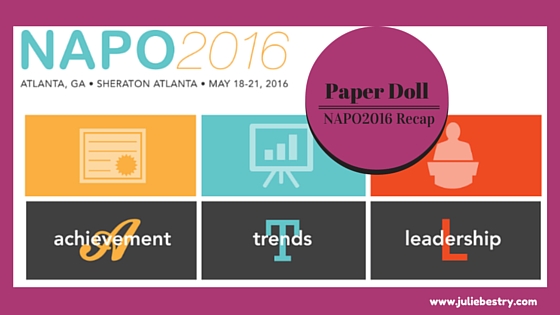
Organizing is about losing (getting rid of things that no longer serve your goals, whether that’s clutter or bad habits) and winning (freeing up space in your home and office, time in your schedule, and peace in your thought processes).
Every year, the attendees of the National Association of Professional Organizers’ NAPO Conference and Expo vote for the best of the best among exhibitors. Categories in the 2016 NAPO Organizers’ Choice Awards include the best residential and business products, the best residential and business services, and an overall “Best In Show” award for whatever really captured the attention of the professional organizers and productivity experts in attendance.
And the winners were…
BEST RESIDENTIAL PRODUCT: Time Timer (modeled by Heather Rogers)
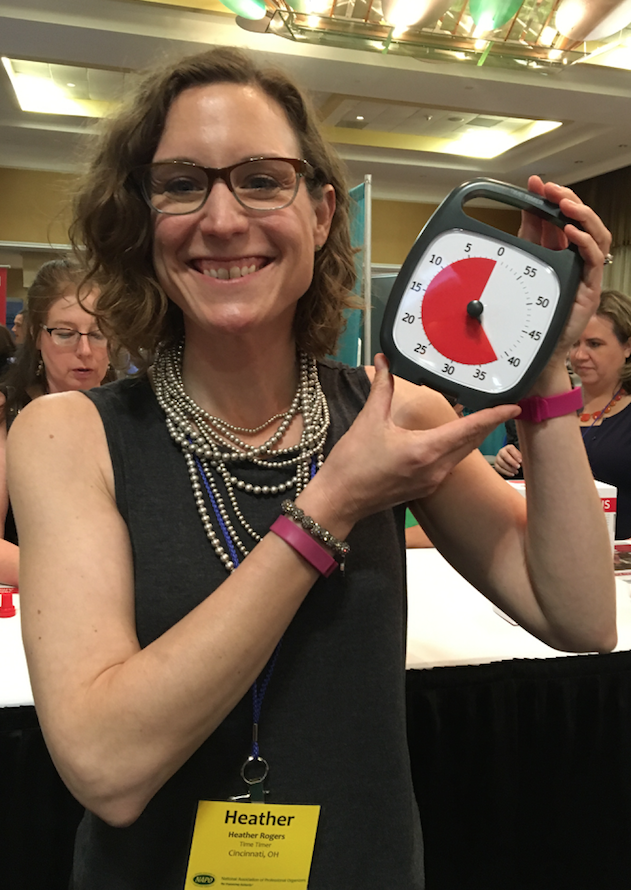 Few time management products could be considered more of a classic than Time Timer, which was already a beloved tool when I started my professional organizing business more than 15 years ago. At that time, back when dinosaurs roamed the earth, I owned one of the original Time Timers, an analog timer with a patented thick, red, circular “fanning-out” disc-like covering that diminished in size (from a maximum of 360° coverage for an hour) until time was up, and the red portion disappeared (hiding behind the clock display).
Few time management products could be considered more of a classic than Time Timer, which was already a beloved tool when I started my professional organizing business more than 15 years ago. At that time, back when dinosaurs roamed the earth, I owned one of the original Time Timers, an analog timer with a patented thick, red, circular “fanning-out” disc-like covering that diminished in size (from a maximum of 360° coverage for an hour) until time was up, and the red portion disappeared (hiding behind the clock display).
It was obvious that Time Timer provided a superlative way to explain the passage of time in a variety of circumstances — for teaching children the concept of time, for giving all participants in a discussion group equal time speaking (without needing an orchestra to “play them off”), for keeping meetings on task and on time, and for helping clients with ADHD and other time-related challenges master their appreciation of the passage of time. Let’s let Time Timer tell it:
The Time Timer product line has expanded in a variety of ways. From the original boxy Time Timer, there are now six varieties:
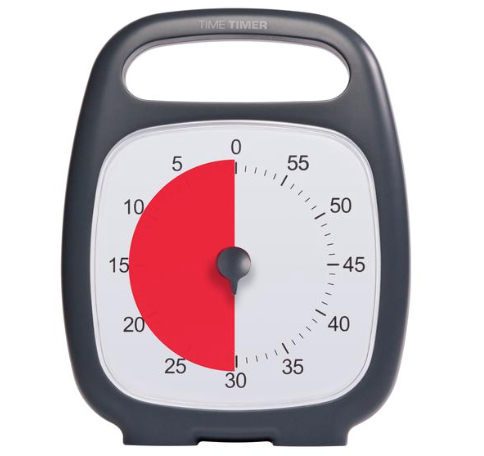
- Time Timer PLUS, with a quick-grab handle, a rugged case, and a durable clear lens to protect its patented red disk, measures 5.5″ x 7″ and requires one AA battery. It’s whisper-silent.
- Time Timer 3″, tiny enough to be tucked anywhere
- Time Timer 8″, perfect for your desktop, bedside, or anywhere you’re working
- Time Timer 12″, ideal for an office or meeting session, so you can see it from across the room
- Time Timer MOD is a 3.5″ x 3.5″ version that adds a little color to your productivity. The MOD features a colorful, removable, silicone cover for an extra layer of protection, like a thick smartphone skin. You can purchase the MOD with a Sky Blue, Charcoal Gray, or Lime Green cover, and there’s a Berry cover available separately.
- Time Timer MOD Sprint Edition ties in with the Jack Knapp book, Sprint, and comes with a Quick Start Guide highlighting the key principles of the “design sprint” framework developed by Google teams.
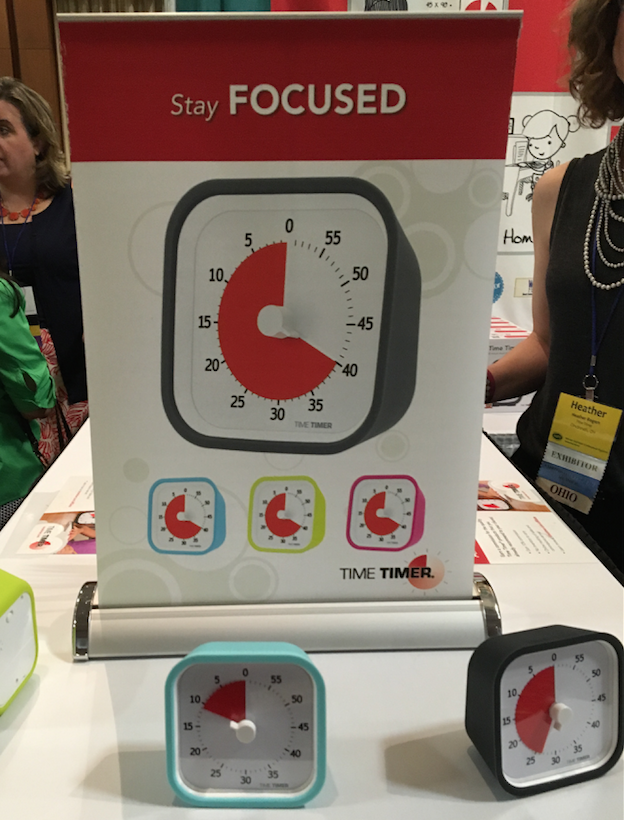
These Time Timers range from $29 to $39 on the Time Timer website.
Over the years, the Time Timer line branched out to include watches for a personal approach to managing time, from staying on task at work, home, or while doing school work to remembering to take medications or transition to the next location or task.
- Time Timer Watch PLUS Small — The small watch comes in Berry, Sky Blue, and Lime Green, with clock, timer, and alarm functions, vibrating and audible alerts, repeatable time segment settings (for interval training, Pomodoro productivity, etc.). The small watch has a soft silicone watch band designed to fit wrist circumferences of 4.75″ to 7″.
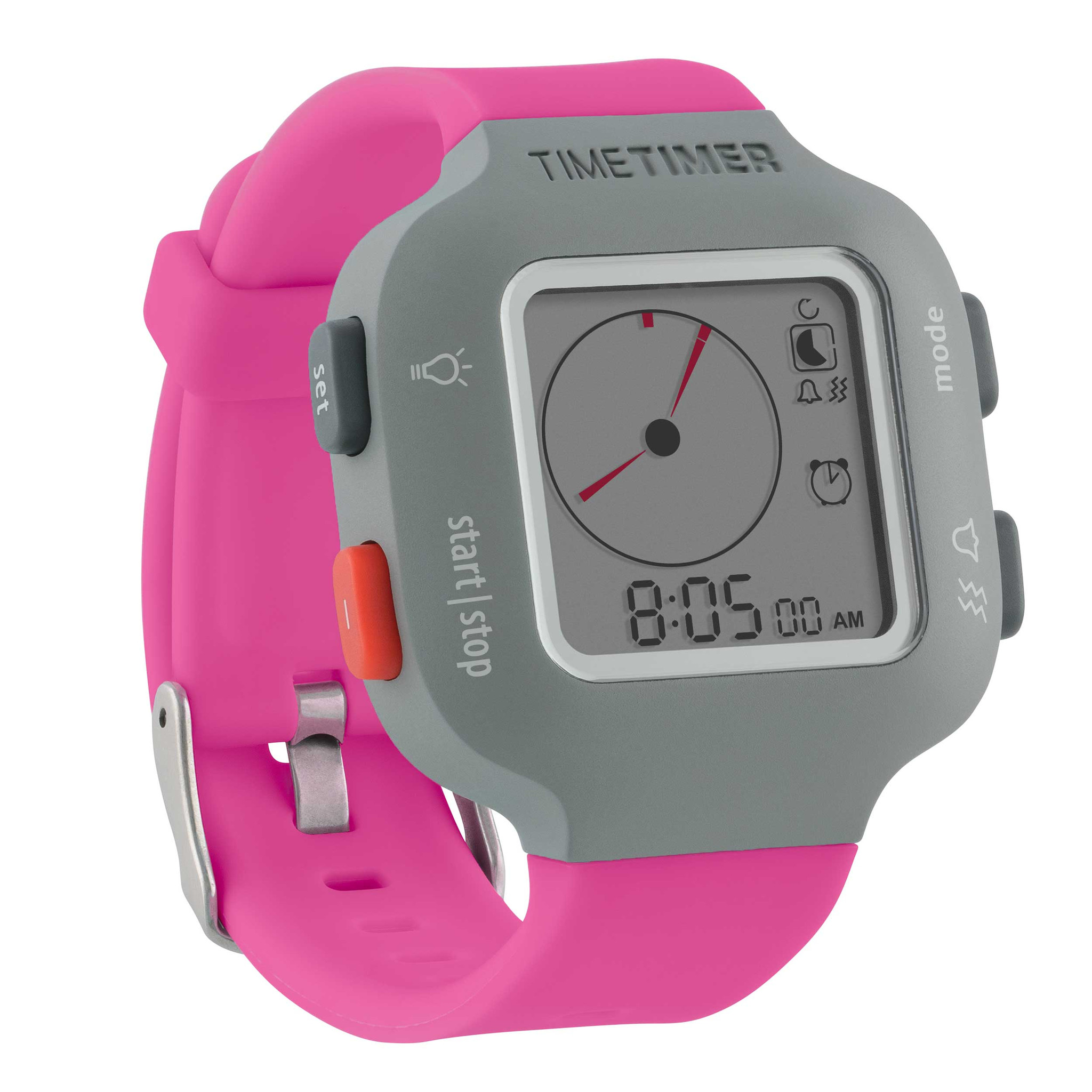
- Time Timer Watch PLUS Large, for larger wrists, has all of the same features, but measures 5.5″ to 8.25″ and comes only in Charcoal Grey.
Both styles of watches are $84.95.
Finally, because the need for time management doesn’t just live in the tangible world, there are Time Timer apps for the iPhone, iPad, Android phones, as well as Mac and Windows apps, offering customized timers. Prices range from $0.99 to $19.95.
BEST BUSINESS PRODUCT: Fujitsu ScanSnap
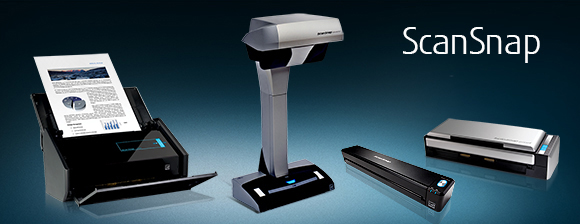
Longtime readers of Paper Doll know that good paper management sometimes means determining which information should exist in digital form, and that means mastering the skill of scanning.
Two years ago, in NAPO2014: Wirelessly Scanning the Horizon — What’s New in Scanning?, we looked at the Fujitsu ScanSnap iX500 Desktop Scanner. With an output resolution of up to 600 dpi for black and white (and 300 dpi for color), the ability to scan single-sided or duplex, a 25 page-per-minute scanning speed, a 50-page automatic document feed, one-button searchable PDF creation, and wireless scanning to Mac, PC, iOS or Android devices, the iX500 is still the belle of the scanning ball as far as professional organizers and productivity experts are concerned.
But the iX500 is only one member of the ScanSnap family, which also includes the mobile, handheld Fujitsu Document Scanner ScanSnap iX100. This little guy is only 14.1 ounces, so it lets you scan receipts and contracts on a business trip, school notes from the library or college dorm, or recipes and plastic ID cards from anywhere to your PC or Mac as well as well as your iOS or Android device. Via USB or Wi-Fi, the iX100 lets you scan to PDF (or even searchable PDF, if you’re using your computer), JPEGs, editable Word and Excel docs (again, on the computer), and send your scans via the ScanSnap Cloud feature to your Dropbox, Evernote, Google Drive, and other cloud services.
Paper Doll has often covered the best ways to decide if and what to scan, in classic posts like in Get Organized Month: Paper Control 102–Advanced Topics & Office Hours and Paperless vs. Less Paper: 6 Ways to Reduce Paper Consumption. However, I recognize that when it comes to the intricacies of the technical side of scanning, I am definitely not the ultimate expert. That’s why, on your behalf, dear readers, I rub elbows with someone who is. (Actually, in this person’s case, he’s super-tall, so his elbows would probably clock me in the ear, but you get the idea.)
If you’re new to going paperless, you definitely want to become familiar with Brooks Duncan of DocumentSnap. Start with his blog post, Going Paperless in 5 Easy(ish) Steps, and move on to his website for others of his gems:
- DocumentSnap Blog — from scanning into Evernote (and exporting out of it) to creating your own private cloud to document search, Brooks is your guy.
- Sign up to get his Paperless Cheat Sheet (linked from the front page) so that you can approach scanning in the right way.
- If you’re going to go the ScanSnap route, look into his Unofficial ScanSnap Setup Guide ($5 each for Mac or Windows, $8 for both.)
- And finally, if you’re thinking of scanning to the cloud, check out Brooks’ Paperless Security Guide, which, at $7, is a steal.
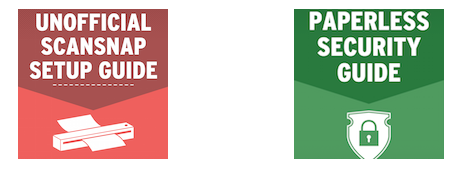
In addition to Time Timer and ScanSnap, the two big productivity stars, other winners of the 2016 NAPO Organizers’ Choice Awards included:
BEST BUSINESS SERVICE: NAPOSure
NAPOSure offers customized professional insurance for practitioners in the organizing and productivity fields. This includes coverage for property, loss of income, professional liability, auto, and employee bonding.
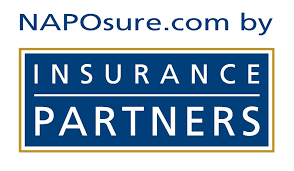
Because the federal government is slow to assign new NAICS industry classification categories, many professions that have existed for multiple decades (including professional organizers and productivity experts, coaches, ADHD specialists, and a variety of technology-related professionals) lack aAICS categorization, which makes it difficult to ensure appropriate professional insurance. For years, professional organizers were categorized by insurance companies as interior designers, even though that coverage approach was, at best, inappropriate. NAPOSure was the first insurance designed and customized for professional organizers.
Metropolitan Organizing’s Geralin Thomas has an excellent short post on How To Get the Best Insurance Coverage for Your Organizing Business, including selecting the appropriate types and levels of coverage.
BEST RESIDENTIAL SERVICE: 1-800-Got-Junk
We know that even if our clients are comfortable with purging the excess from their homes, not everything can find its way to a logical and useful next “home” via consignment or donation. Sometimes, stuff is broken, too far out of date, or otherwise too damaged to be of use to anyone, and that’s when 1-800-Got-Junk comes to the rescue. If you’ve got something non-hazardous that “two strong, able-bodied crew members can lift,” then they can get it out of your space.
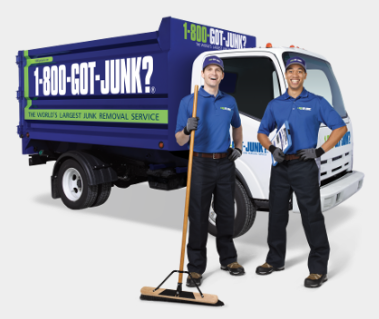
This full-service junk removal company offers the upfront pricing, convenient pickups, and responsible disposal services that make professional organizers and our clients feel confident using. 1-800-Got-Junk was voted Best Residential Service, because they’ll pick up your household detritus, including old appliances and TVs, mattresses, furniture, carpets — even hot tubs! But they also service businesses, and will remove “junk” and recycle computers, monitors, and printers from your office space.
BEST IN SHOW: Lock & Rollin’ Flooring Solutions
I’m a generalist, working with both residential and business clients, but I specialize in paper and information management. So, I’m not often involved with garage and attic organizing systems, or other “heavy-duty” tools. However, clients are often looking for recommendations, and it was interesting to learn about Lock & Rollin’s Flooring Solutions.
Designed to help turn attics and crawl spaces into safe storage options, Lock & Rollin’ uses 32″ lightweight slats which slide together to form adjustable lengths of roll-out flooring that fit between attic joists. The creators state that it holds up to 250 pounds per square foot while being lighter than typical attic flooring, like plywood, so it should be easy enough to lift and carry, and they say it’s resistant to mold, mildew, and termites.
Lock & Rollin’ was surrounded by crowds throughout the conference, so all I could see while craning my neck was something that looked like a seriously heavy-duty Transformers-style yoga mat. At the risk of associating myself with an annoying “As Seen on TV” late-night commercial, as someone who fears falling through an unfinished attic floor, I found this video to be both explanatory and intriguing.
Congratulations to all the NAPO2016 Organizers’ Choice Award Winners!
Disclosure: Some of the links above are affiliate links, and I will get a small remuneration if you make a purchase after clicking through the links. The opinions, as always, are my own. (Who else would claim them?)
Paper Doll’s NAPO2016 Recap: Smead Takes On Coloring, Minis, and Corners

As we discussed in last week’s Paper Doll post on Samsill’s new products, there’s a particular delight to the pseudo-shopping aspect of attending the NAPO Expo. For me, there’s a specific magic in the air when I get to see exciting new products from our industry stalwarts, and nowhere is that more true when I get to see new paper management products.
Yep, I’m an office supply fangirl. Particularly a paper-related office supply fangirl. That may explain why, although I love all my NAPO Corporate Associate Members and NAPO Conference Expo vendors, I have a special place in my heart for my friends at Smead, who have been kind enough to have me on their Keeping You Organized video podcast twice, once to talk about small business organizing, and again to discuss organizing-related fears.
So, of course, as soon as NAPO President Ellen Faye cut the Expo ribbon with those giant scissors, I made a beeline to my Smead buddy, Leiann Wright.
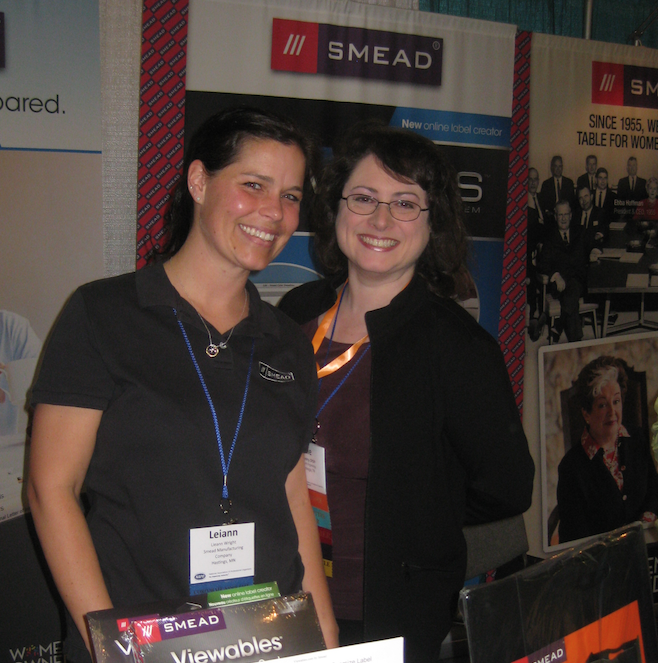
With file folder aficionados (say that three times, fast) crowding around the booth, it took three visits over two days to learn everything about the new offerings, and I’m still finding items in the 2016 New Product Guide that I missed in person!
Today, we will focus on just a few of the new products that had conference-goers talking.
SuperTab® Coloring Folders
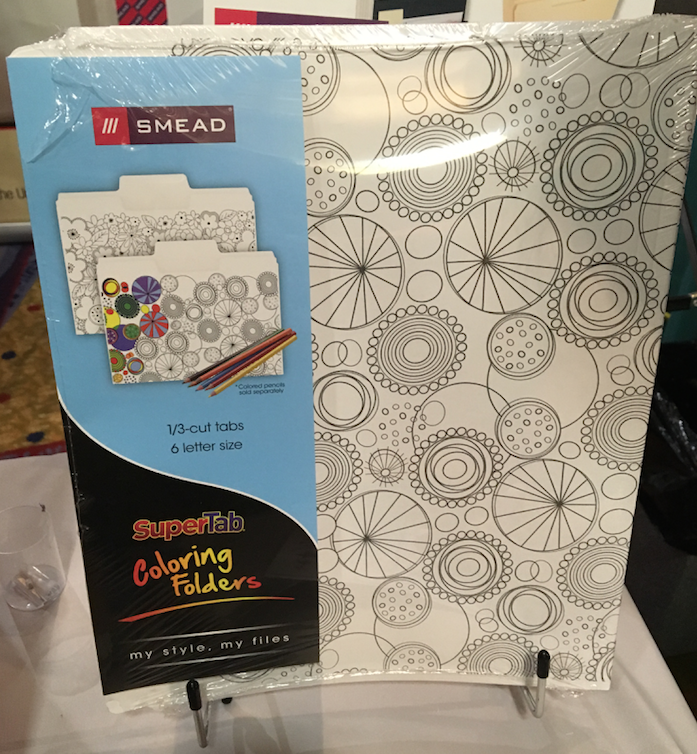 Smead’s SuperTab® folders aren’t exactly new. I originally reviewed them back in Paper Doll Dishes Out the Super Goodies back in 2011. Back then, I explained that with larger tabs, one could:
Smead’s SuperTab® folders aren’t exactly new. I originally reviewed them back in Paper Doll Dishes Out the Super Goodies back in 2011. Back then, I explained that with larger tabs, one could:
1) Use Larger Text — This makes it easier to see labels from across the room, assists those with all variety of vision issues from aging eyes to macular degeneration, and ensures that offices with files bearing many similar-appearing labels (Johnson/Jonson/Johnsen) can be discerned with relative ease.
2) Use Multiple Lines of Description — Although brevity is the soul of wit, and although we professional organizers usually advise keeping file folder labels as simple as is serviceable, sometimes a label just has to say more.
3) Use Icons — In addition to labels, colored dots, stickers and other icons can be used to help categorize the content of a folder, and the larger the tab, such as with SuperTab® folders, the more expansive the available space for adding definition and clarity.
This new product takes the practicality of the 90% larger tab of the original SuperTab® and combines with a colorful new trend.
As Paper Doll doesn’t have any artistic inclinations (and recently went into anxiety-mode at a recent visit to one of those paint-the-pottery places), I have long wondered what it was about these best-selling and highly coveted adult coloring books I was missing. So many of my high-profile colleagues, including Deb Lee, Janine Adams, and Danielle Liu, enjoy this pastime that this year’s NAPO conference planners added a lounge area with oversized coloring pages at which my friends could be found doodling in spare moments, when in prior years, they might have chugged coffee or returned phone calls.
If you’re unfamiliar with this latest habit of adults pulling out crayons and markers to color, I direct you to A Neuroscientist Patiently Explains the Allure of the Adult Coloring Book from New York Magazine. My favorite aspect of this article notes:
Our prefrontal cortex is responsible for coordinating thousands of decisions each day, from which socks we should wear to life-altering relationship and career choices. As an unconscious response to this so-called daily “decision fatigue,” making a series of small, inconsequential decisions (teal or mahogany for this squiggly line?) may give us a refreshing sense of self-control after a long day of big, important ones.
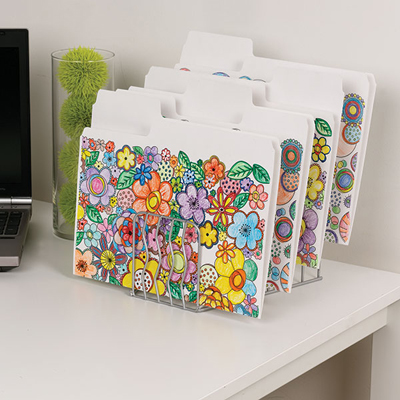
Smead SuperTab® Coloring Folders are letter-sized and come in geometric and floral designs. The tabs are 1/3-cut and constructed of 11 pt. (reinforced) paper stock, which works with colored pencils, crayons, and markers. The bottoms of the folders are scored for up to 3/4″ expansion, and all folders are made of 10% recycled content with 10% post-consumer material.
I should note that 11 pt. paper stock is a little less robust than the 14 pt. heavyweight folder stock I prefer, but I suspect that for typical office work, aesthetic appeal may outweigh (pardon the pun) sturdiness for those who are visually focused or inclined to reduce stress with conference call coloring.
Find the Smead SuperTab® Coloring Folders at office supply stores and Amazon, in packs of 6 or 12, with a dozen running about $12.
Mini Stadium® File
Fans of the original Smead Stadium® File, which we reviewed in our NAPO 2010 Conference Expo Recap, liked the fact that it was portable, lightweight, and (surprisingly) sturdy. It had 12 pockets, could hold up to 900 sheets of paper, and most importantly, was stepped like a riser or stadium to ensure that nothing could be hidden.
The Mini Stadium® File has many of the same features as the original, but is more compact, so it’s suitable for correspondence and small projects you need to keep on your kitchen counters, dorm room desks, and small offices. As always, the idea is that if you clear your paper clutter, categorize it, and contain it, you’ll get your space and sanity back. Smead has taken this approach to the desktop file box and made it fun-sized.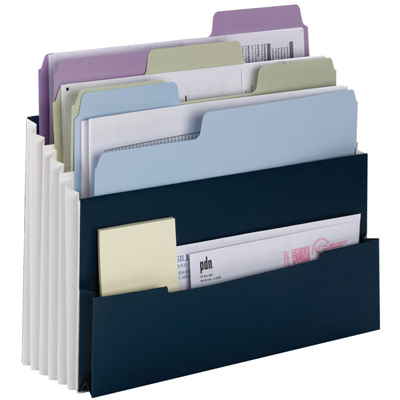
The three pockets are tiered and fixed so the papers don’t fall to the bottom of the organizer, and is suitable for holding both papers and folders. There’s also a small, low-profile, flat outer pocket. Like its predecessor, the Mini comes in Navy with fully lined Tyvek® gussets to allow for expansion. The Mini also includes labels for alphabetical (A-Z), monthly (Jan-Dec), and daily (1-31) filing, as well as household subjects and blank indexing.
Right now, the Smead Mini Stadium® File seems to be sold primarily at smaller online office supply stores and at Amazon, where it costs $19.95.
Corner Organizer File
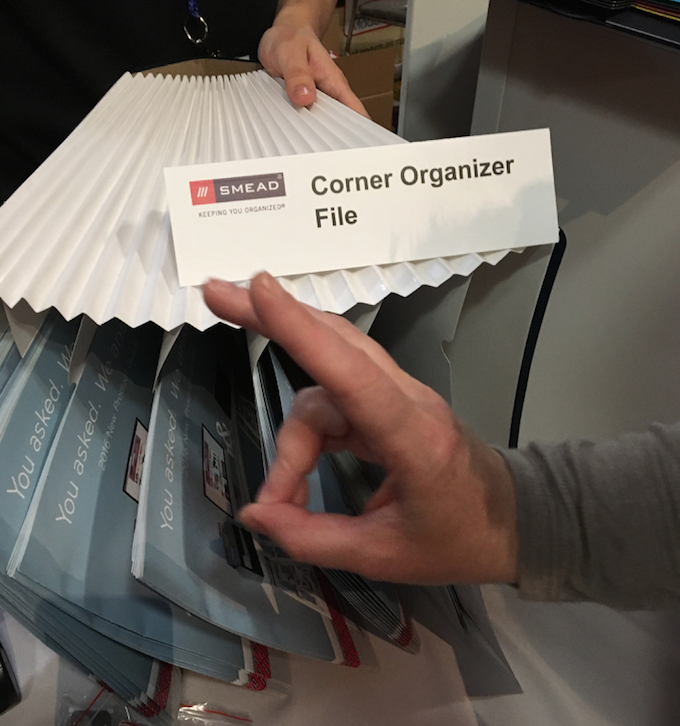
Smead Corner Organizer, with Bunny Ears
While the two prior products are updates of popular Smead products, the Corner Organizer File seems to turn a product on its head, or at least its side. Picture if the traditional Stadium were turned 90° and cut on an angle to provide accessible storage in a corner, where two walls, a desk/wall edge, or the top of a filing cabinet meets a cubicle divider. Paper Doll‘s first thought was that it worked to make typically dead spaces more accessible much like Lazy Susan kitchen cabinets allow you to store food or small appliances in the netherworld where two cabinets meet at right angles.
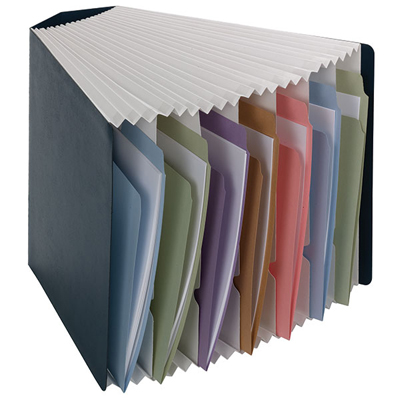
Smead’s Corner Organizer is letter sized, Navy with a white interior, and has seven expanding pockets. It’s suitable for storing top-tab and side-tab folders. Like the Mini Stadium® File, the Corner Organizer File doesn’t seem to be distributed by the major office supply big box stores, but you can find it at a variety of smaller and online stores, as well as Supply Geeks and aAmazon for about $28.
These are just a few of the Smead products that caught my eye at NAPO2016. Be assured that after our recap series, I’ll be circling back to discuss some of their fun new poly products — poly expanding files, poly file boxes, and poly pockets — as well as new document wallets, line extensions for Viewables, and soooo much more about folders. Until then, enjoy this photo of professional organizer Lita Daniel showing of her grown-up approach to today’s moment of Zen.
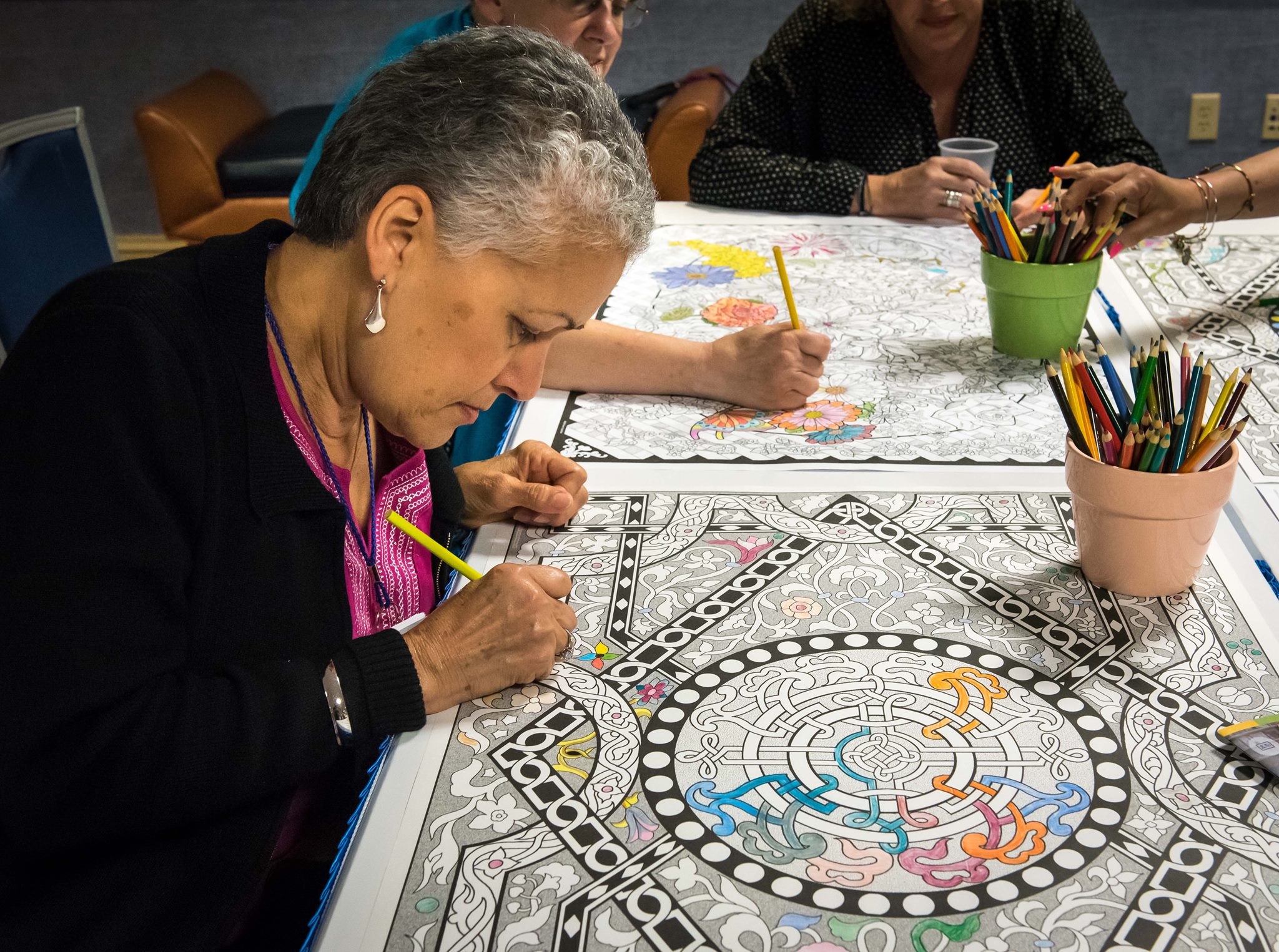
Photo courtesy of Dan Slutsky, NAPO Photographer Extraordinaire
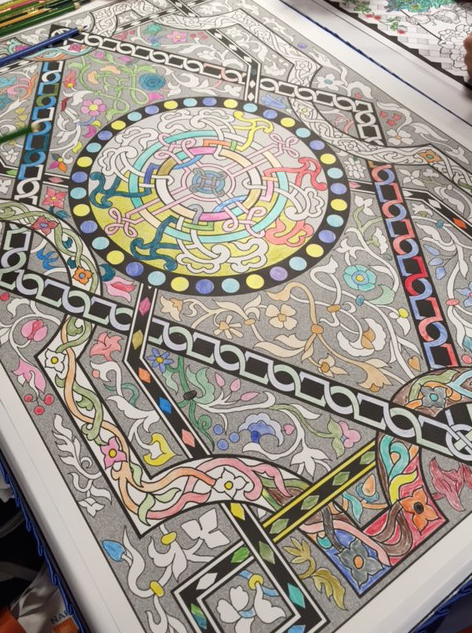
Photo courtesy of Ellen Delap, NAPO President-Elect
Paper Doll’s NAPO2016 Recap: Samsill’s Duo & Trio & Pop…Oh, My!
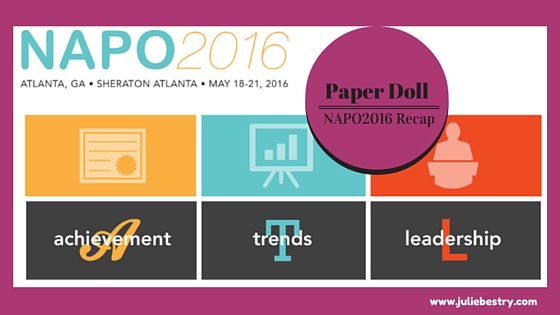
Last time, we covered the conference aspect of NAPO2016. That’s the part that’s a mixture of college courses (education), class reunions (networking), and cocktail parties (food, beverages, and entertainment). But Paper Doll knows that you come here for the expo talk — you want to know about the shopping!
This year, we start with a newcomer, a vendor we’ve not seen before at NAPO conferences, Samsill. If Samsill were a person, it would be almost old enough to collect Social Security, but it’s not as well-known as some of its competitors in the world of office supplies.

Samsill showcased three products that really got attention at this year’s NAPO Expo.
Duo 2-in-1 Organizer

The Duo is the first of two hybrid products from Samsill. It combines a seven-pocket expanding accordion file with a 1″ three-ring binder. The accordion file portion holds up to 225 sheets of paper, while the accordion-style expanding portion includes blank write-on index tabs so you can customize your labels.
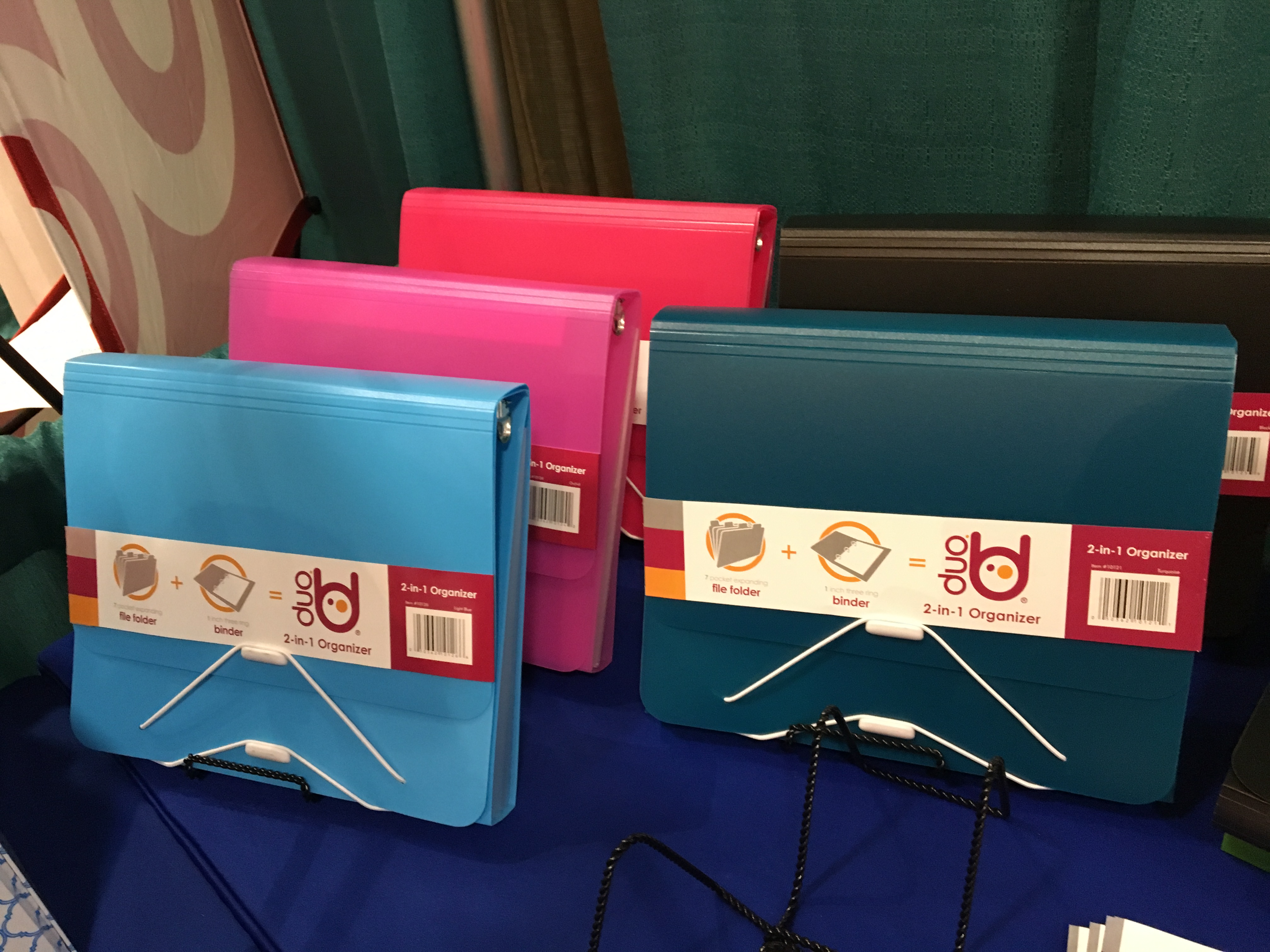
The Duo has a dual elastic clasp and cord closure to provide access to each portion (pockets or binder) individually while maintaining a secure closure to either or both sections. The Duo weighs 14.6 ounces and measures 9.8″ x 1.5″ x 11.8″.

Here, we see Paper Doll friends and colleagues Nanette Duffey and Michelle Cooper modeling the flexibility of the Samsill Duo.

Think of the Duo as a grown-up Trapper Keeper in which you can store tax prep or financial information (budget, bills, coupons, and shopping lists), family medical files (with categories for tests, prescriptions, and dietary rules), or household plans (with sections for decorating, monthly upkeep, garden plans, etc).
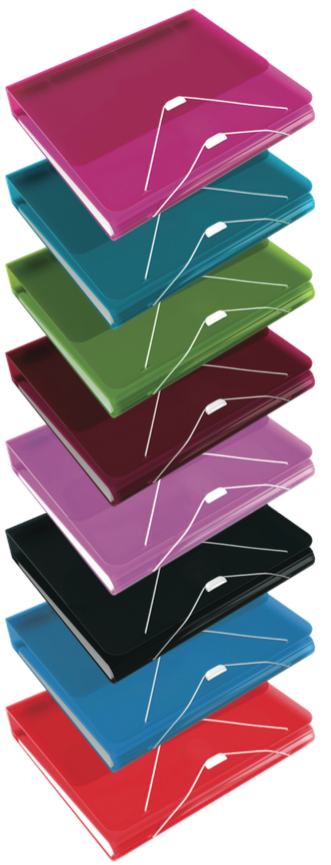
The Samsill Duo is lightweight and flexible, but durable and water-resistant, and is made of PVC-free, acid-free, archival-safe environmentally flexible polypropylene. (Paper Doll fans know that while I am a paper doll, I do love my poly products!) The Duo comes in Hot Pink, Turquoise, Green, Burgundy, Orchid, Black, Light Blue, and Coral.
Find Duo 2-in-1 Organizers at Amazon for about $10.79.
Trio 3-in-1 Organizer
With the Samsill Trio 3-in-1 Organizer, you still get:
- the seven-pocket expanding accordion file folder (which holds up to 225 sheets of paper)
- the 1″ three-ring binder with blank write-on index tabs so you can customize your labels
- the dual elastic clasp and cord closure which allows you to open or close the areas independently of one another
- PVC-free, acid-free, archival-safe environmentally flexible polypropylene
- the same weight and measurements
BUT WAIT, THERE’S MORE!
The Trio also has retractable hangers which turn the TRIO into a hanging file, so you can store it conveniently in a file cabinet, desktop file box, or filing drawer in your desk without fearing that it will sink below the visibility of other files or worrying that the poly will make it slide to the bottom of the drawer.

Store your ringed notes, sort and organize your handouts, bills, and paperwork, closed it all, secure the binder, and safely file away your Trio when you’re not using it.
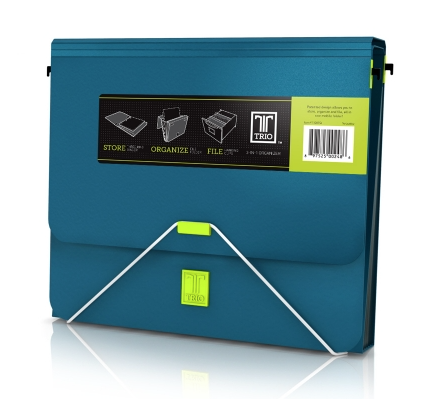
The Trio currently only comes in only two colors, Black (sometimes labeled Dark Grey) and Turquoise, but I’m sure if you all let them know how much I’d like them in Hot Pink and Burgundy, the people at Samsill would be happy to oblige. Find the Samsill Trio for about $9-11 on Amazon.
Both the Samsill Duo and Trio are eminently designed for durability, portability, and storage. They — particularly the Duo versions — are bright and colorful. However, there is significant “floppyability” about this combined binder/accordion file when open, and poly can be slippery, so these are probably more suited to office supply use than for younger school-aged kids (or adults, I guess) without sufficient fine motor control.
Pop N’ Store
The Belle of the Samsill Ball was definitely their line of Pop N’ Store boxes, which offer innovation, practicality, and aesthetics. The Pop N’ Store’s space-saving folding-box system is sold flat-packed, but POPS from flat to popped up in five seconds. Samsill’s patent-pending locking system holds the boxes’ bottoms in place, so they are entirely suitable for stacking.
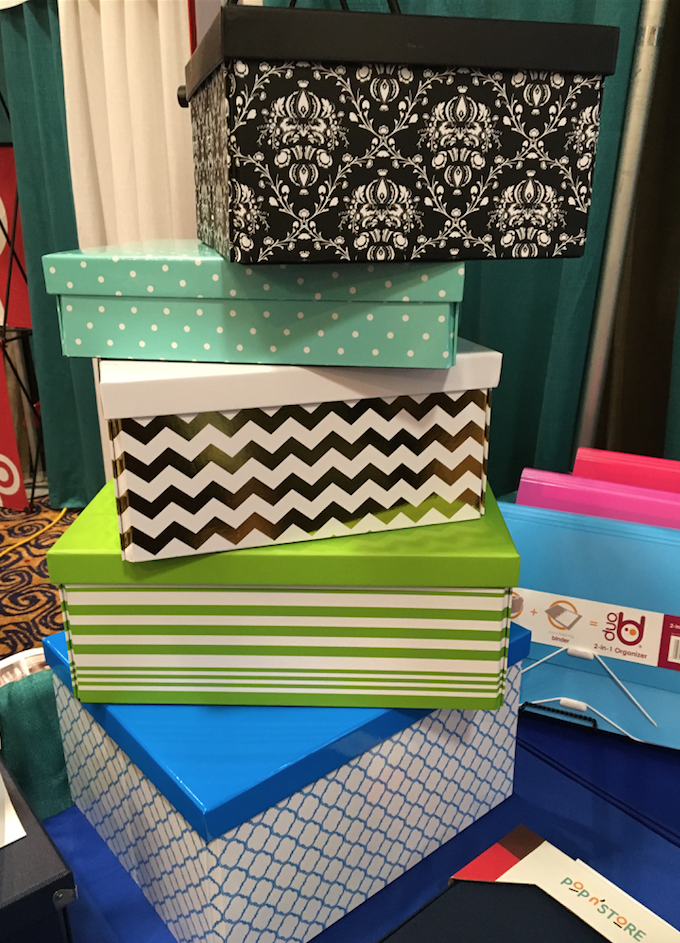
The double-thickness walls of the boxes are made of heavy-duty chipboard and are covered with
Lotus Seed™ textured paper, and the box bottoms are covered in scratch-resistant fabric to protect delicate surfaces in your home or office and offer a touch more support for the contents of any box. And the box corners are metal-reinforced to add durability and smart accenting.
The boxes are made of 100% recycled material and 70% post-consumer material.
These lidded, decorative storage boxes come in five sizes with the following (internal) dimensions:
- Document Box (12″ x 8.5″ x 3″)
- Essential Box (14.625″ x 7.5″ x 5.34″)
- Medium Document Box (12″ x 8.625″ x 5.8″)
- Medium Square Box (9.75″ x 9.75″ x 5.75″)
- Mega Box (14.625″ x 11.875″ x 7.34″)
The boxes currently come in Black, Navy, Red, Brown, Grey and White. (At press time, Paper Doll was awaiting word on the availability of the colorful, patterned versions shown above, but we have learned that these are prototypes for future line extensions.)
Pop N’ Store lets you organize everything from linens to office supplies, gifts to crafts, toys to CDs, to whatever you want to store: tucked away, stacked, shelved, and shown off. Find them at Amazon from $11.99 to $16.99.
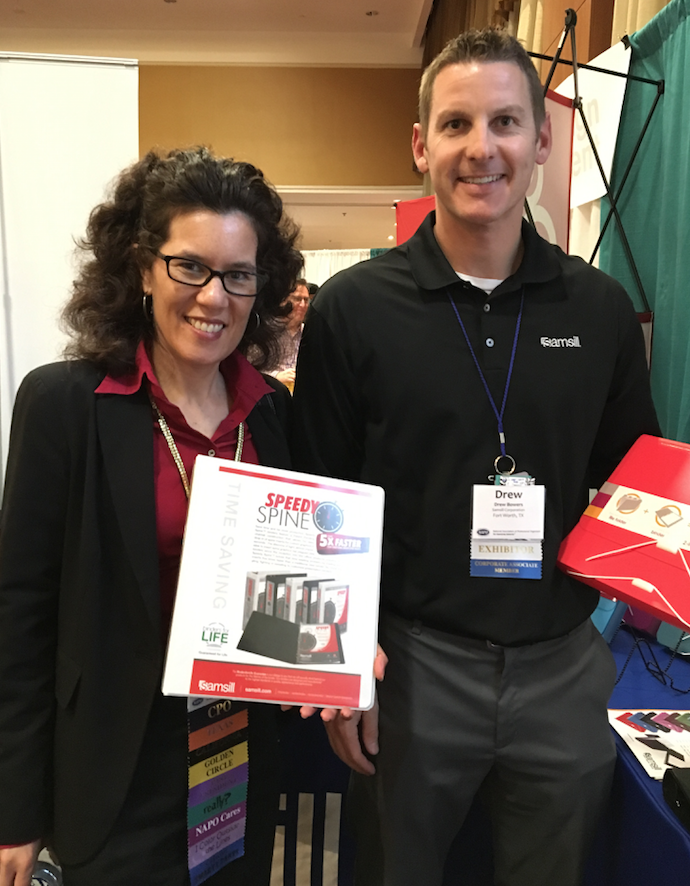
The Due, Trio, and Pop N’ Store are just a few of the items Samsill had on display at NAPO2016, and just a small subset of their wares. Samsill is best-known, for example, for their traditional three-ring binders in traditional and D-style rings. Above, Samsill’s Drew Bowers with my NAPO and BCPO® colleague Helene Segura are showing off the Speedy Spine, which purports to let you insert spine labels five times faster than other types of binders.
Samsill also makes Heavy Duty Clean-Touch Anti-Microbial binders (to keep you germ-free in a medical setting or around jam-handed colleagues), value-priced storage binders, Earth’s Choice™ Biobased + Biodegradable Round Ring View Binders, traditional poly round-ring binders (suitable for schlepping to Social Studies), truly enormous 6-inch capacity binders, and a collection of 1″ Fashion Print round-ring binders.
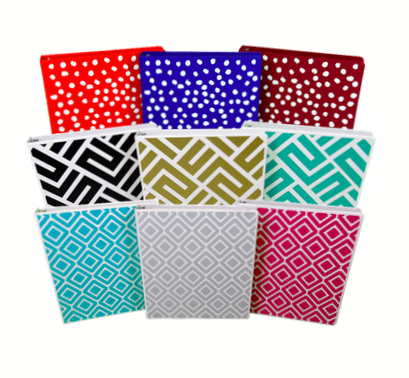
Samsill also makes padfolios, business card holders, laptop cases, tablet sleeves and a variety of other office supplies, and I’m looking forward to what they will be displaying at NAPO2017. From their website, it appears their retail locations are primarily in Kansas and Oklahoma, but you can find all of the above products on Amazon.
Paper Doll’s NAPO 2016 Conference Recap: The Wisdom Edition
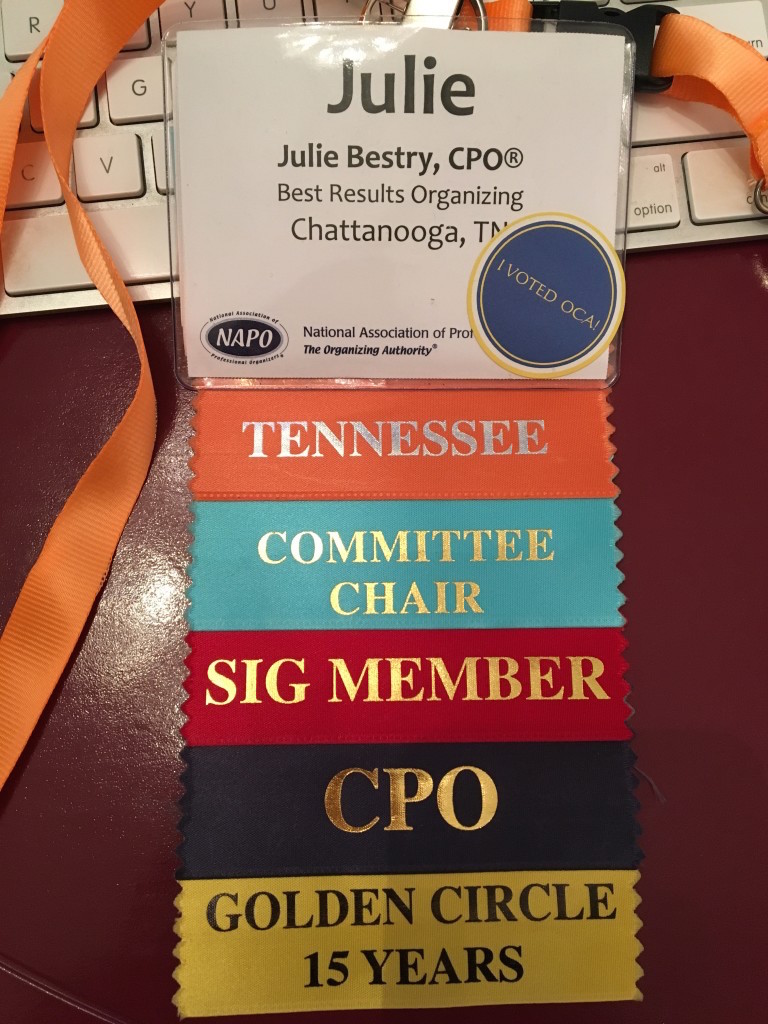
NAPO TIME!
As is the annual tradition at Paper Doll HQ, this is the time of year where we step away from paper-related topics to look at the bigger picture of what’s going on in the organizing world. The Annual Conference and Expo of the National Association of Professional Organizers was held just down the road from me this year, in Atlanta, GA.
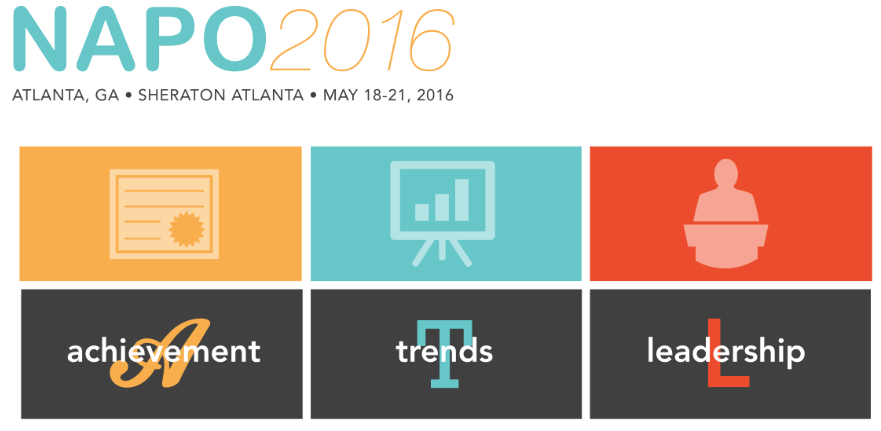 The atmosphere as everyone starts arriving at a NAPO conference is like the first day of summer camp — or a college reunion. We’ve all seen each other on social media, but it’s a delight to view my colleagues when they’re bigger than their one-centimeter high avatars.
The atmosphere as everyone starts arriving at a NAPO conference is like the first day of summer camp — or a college reunion. We’ve all seen each other on social media, but it’s a delight to view my colleagues when they’re bigger than their one-centimeter high avatars.
The first full day is all about preliminary, but important, activities. On Wednesday morning, I attended the Angela F. Wallace Leadership Forum, where we learned techniques and strategies for encouraging and motivating volunteers. In the afternoon, I participated in lively discussions at our meeting of the Board of Certification for Professional Organizers, for which I serve as the Director of Program Development (also known as the Sacred Keeper of All Rules Persnickety) and as the local grammar and spelling cop.
SETTING THE TONE
Our opening keynote speaker, Scott Greenberg, presented The Third Factor: The Mindset for High-Performance Leadership.

Scott spoke about the three factors that influence success:
- External factors that we can’t personally control, like the economy, what our competition does, the weather, our own DNA,
- Operational factors, over which we have a bit of control, like if we work long enough and hard enough,
- Mindset, or how we think about things, and whether we have a fixed mindset (and believe that we have little-to-no control over our own qualities) vs. a growth mindset, one in which we can improve and grow.
Scott talked about the importance of making interpersonal connections and having gratitude, but my biggest takeaway from his motivational presentation was that it’s not just about the tangible (or even temporal) clutter, but about the “head trash” piled up by our mental hecklers. Scott encouraged us to externalize what these internal hecklers were saying to us so that we could fully appreciate the flaws inherent when we are deprecating ourselves. If you followed any of the tweets from our #NAPO2016 hashtag, you would have seen how much we all embraced Scott’s parting wisdom:
EDUCATIONAL SESSIONS
After the welcome and keynote, we moved on to the meat of our conference sustenance: our concurrent educational sessions, where, over the course of three days, we have the choice of attending one of five classes in each of six concurrent sessions. Somehow, just going to six out of thirty amazing presentations does not seem like enough!
While I work with residential as well as business clients, this year, my focus was on technology and productivity. Courses I took included:
The Art of Tactical Time Management — If you don’t follow the blog and podcast of Mike Vardy, the Productivityist, you’re truly missing out. Perhaps Mike’s presentation resonated with me so much is because it dovetails with what I teach my own clients. For example:
You’ve heard me say this before — if we try to keep things in our heads, or if we leave tangible items out (on our desks, and around our computers, and blocking our doors) to trigger us to think of something, that’s all we do. We think of them, but the energy we waste on remembering something and thinking of it, instead of about it, contextually, is wasted energy. Capture it — write it down on paper or save the thought digitally — and then you can move forward toward your goals.

Mike also talked about “time theming” similar to the task-and-time blocking I discussed in my book, 57 Secrets to Organizing Your Small Business (the revised and newly named edition of which will be out later this year). Mike’s time theming (for the year, the month, and the days of the week) is central to his NOW Year Method, about which we learned extensively in the session. I won’t give out those details and spoil Mike’s brilliance — you definitely want to check him out, but I’ll leave you with another of his bon mots.
Other sessions I attended included:
The Paradox of Technology in Business (and Life), in which Nadine Seidman, MSW, MPA, and Nancy Kruschke, CPO®, looked beyond the benefits of technology (communication and collaboration, mobility, and productivity) to the darker costs of technology, including financial (initial and ongoing), physical/health (sleep interruption, neck and back pain), societal (reduced privacy and diminution of etiquette), and psychological (depression, anxiety, and overwhelm). Nadine and Nancy shared great tips for professionals to create “response time policies” for setting expectations for how often, when, and by whom business replies will be made, and encouraged us to unplug ourselves, personally, to recharge. (Just be sure you wait until after you finish reading this post.)
Achieving Balance and Creating Peace with Organizing, where my colleagues Amy Trager, CPO®, and Suzy Margolis Hart used philosophies from the practice of yoga to discuss how we might work better with our organizing and productivity clients. As I once explained on a Smead EZ Grip product testimonial video, Paper Doll has weak, wimpy wrists and appreciates, rather than practices, yoga. However, the messages of this session, from the philosophical — “There is no perfect” — to the practical — how to be non-judgmental, reduce unpleasantness, improve flow, and maintain boundaries — are things we can all use in our work and daily lives.
Down With Digital Clutter, taught by my colleague Pam Holland, seemed to bookend the class on the paradox of technology, and offered up a cornucopia of advice and tools on how to eliminate the clutter that technology builds up. I liked that Pam went against the modern grain (as I do), championing the idea of organizing and building infrastructure for your digital files instead of relying on search technology. My favorite tip, however, and one I intend to keep reminding myself, was that it’s important to remember to empty ALL of the trash. Just as my residential clients are good at remembering to take out their big (usually kitchen) trash on garbage day, while neglecting the tiny bedroom, office, and bathroom trash cans, we all tend to forget that our computers and digital devices have multiple trash cans — not just our desktops, but our emails, our photo collections, and our individual apps, and if they go unemptied, we waste our resources.
Of course, not all of the educational sessions I took were for helping my clients be more productive. The title of my friend and colleague Deb Lee’s Content Marketing: Blogging Tips for Your Small Business practically damns with faint praise what was a 90-minute master class in creating, researching, writing, promoting, and excelling at blogging.

If you are a small business person (or a big business person), there’s nobody better from whom you can learn how to promote your business — so be sure to check out her newly updated D. Allison Lee website to see how her productivity and technology coaching can rock your world. (Nope, this isn’t a paid promotion. Deb is just THAT good that everyone should know about her.)
For those who were interested in other topics, NAPO had them covered with a variety of tracks for classes I’ve not yet mentioned, including:
Business Growth, Marketing, Leadership: Imperfection Rules! Creative Ways to Run Your Business; Coaching Works: Coaching Meets the Organizing World; How to Be an Independent Contractor; Veteran Forum Interactive; How To Keep Your Business from Becoming theIRS! [sic]; What’s Next? Planning an Effective Business Exit Strategy; Strategic Planning to Grow Your Business; Leveraging a Competitive Market: Building Your Personal Brand
Organizing and Productivity: Closets, Pantries, Cabinets, Offices: Beyond the Basics; Photo Organizing Anxiety and How To Overcome It; Transparent Power: Improve Client Outcomes through Direct Communication; Holistic Time Management; Information Afterlife and the Digital Estate Plan
Specific Needs Clients: Still Someone: Organizing Older Adults with Memory Loss; ADHD in the Family: How to Really Help; Play! The Secret Ingredient to ADHD Motivation
Research: Industry Statistics and Trends; Booming Your Baby Boomer Business: Research-based Understanding of this Pivotal Age Group
Special Interest Groups: Moving Made Easy; How Organizers Engage Students; Seven Truths to Becoming a Published Author
Trends, Technology, and Social Media: Power of Email Marketing for Today’s Savvy Organizer; Digital Eyes: Storytelling through Video Marketing; Profit and Value with Online Training
Even if you’re not a professional organizer, I bet you’re envious now!
FOOD, GLORIOUS FOOD (AND KARAOKE)
We professional organizers and productivity specialists take plenty of time to refresh our brains with rest and relaxation — just as we advise our clients. For years, our NAPO meals were almost all taken together, seated at round tables in large ballrooms where the noise and overcrowding made convivial conversation difficult. (It also explains why I had laryngitis by the last day of our conference ever year.)
And let’s be real. Conference food is generally both uninspired and uninspiring. For vegetarians and others with special food requirements, conference dining has also often been a disappointment. (A plate of steamed bok choi does not a meal make!) However, this year, the Atlanta Sheraton did an amazing catering job, and our meals were far superior to anything I’d been served in my last decade and a half of attendance. Still, the hotel could not handle our volume in the traditional way, so we had more buffets and even got to lunch al fresco by the pool.
My favorite addition to our meal experience was this year’s Dine-Around experiment, where attendees could sign up to eat in small groups at any of a number of local restaurants within walking distance from the hotel. I was amused to find that although I’d arrived two days before the official start of conference and was only the sixth person to sign up for a Turkish meal at Atlanta’s Truva, I was the third Julie. Hence, this photo caption:

And be assured, lest you imagine that our professional organizing community’s lightheartedness extends only to culinary sustenance, let me disabuse you of that thought. Our NAPO President, Ellen Faye, opened the President’s Reception to all attendees this year for a “Black & White” party that included dancing and karaoke.

So, while we value our education, professionalism, and camaraderie, don’t ever believe the stereotype that professional organizers are stuffy.
In the upcoming NAPO re-cap posts, we’ll be looking at the products and vendors who can help make your life more organized, including the 2016 winners of the NAPO Organizers’ Choice Awards.
NAPO 2015: Wardrobe Organizing, Whether You’re Haute Couture or Low Maintenance
Longtime readers of this blog know that it’s a rarity for me to venture into discussing closets and wardrobes. Paper Doll‘s corner of the organizing blogosphere is definitely better suited to paper and productivity clientele than that of fabulous fashionistas, but I’d be remiss in my recapping of the NAPO 2015 Annual Conference and Organizing Expo if I did not share the word about some of the new and returning vendors specializing in organizing clothing and accessories.
Today, we’ll be looking at services for readers with Red Carpet wardrobes and products for those with down-to-earth accessories.
GARDE ROBE®
The word garderobe is French for wardrobe, but Garde Robe® takes that concept a step beyond, delivering what they call a luxury wardrobe storage and valet service. This is no put-winter-clothes-in-a-plastic-tub-and-stick-it-in-the-attic effort.
 Garde Robe offers a wide variety of high-end services, including:
Garde Robe offers a wide variety of high-end services, including:
- Climate-controlled luxury storage in air-purified storage lofts
- Wardrobe archiving for couture wardrobes
- Seasonal storage for off-season clothing, footwear and accessories
- Professional wardrobe photography and cataloging where each garment is photographed and inventoried with descriptions detailing the style number, year, season, line, fabric, size, and item type.
- A Cyber-Closet app, enabling clients to view and manage stored collections in a personalized online catalog — 24/7 — and select individual garments or an entire wardrobe for delivery
- Luggage-packing and worldwide delivery to second homes, vacation destinations and work locales
- “White-glove” pick-up and ready-to-wear delivery service
- Expert garment care, repair and alterations
Whether you’re a CEO or a celebrity or just someone with refined tastes and accessories to match, you can have your wardrobe stored, inventoried, maintained, and delivered to you, wherever you are (or plan to be).
Garde Robe also has a wide array of specialty services, like “museum-quality” preservation of one-of-a-kind and/or delicate garments such as vintage and couture wardrobe pieces, charitable donation assistance, at-home (or at-hotel) tailoring, image consulting, personal shopping and more.
With lofts and offices located in New York, California, Las Vegas, Florida and services available worldwide, Garde Robe’s services are designed to help a wide variety of prospective clients:
- City residents and condo owners who lack adequate closet space or a suitable storage environment (in terms of air quality, humidity, temperature, etc.) for their year-round and special-event wardrobe items
- Multi-homeowners and jet-setters requiring worldwide access to their wardrobe and accessories, wherever work (or life) may take them
- Travelers who prefer a luggage-free travel experience (and, I mean, who wouldn’t?)
- Personal stylists, wardrobe archivists, personal assistants, professional organizers, and other residential staffers who work with clients like those described above
Check out the site to get pricing information.
CASH IN MY BAG™
What if your problem is not that you live and work in too many fabulous places to keep your wardrobe available (and in perfect condition) at a moment’s notice? What if you merely have a bounty of designer items of which you’re no longer enamored? You could schlep your designer handbags, accessories, jewelry, watches, and shoes to a consignment store, but then you’d have to wait to see when (or even if) your items might sell.
That’s where Cash In My Bag comes in — in what’s called the pre-owned luxury market. Instead of waiting for consignment, this service offers a simple, straightforward process for recouping some of the money spent on high-end goodies.
- Complete Cash In My Bag’s short online form, with drop-down menus to identify the designer, category (e.g., handbags, shoes, etc.), condition, age, and if applicable, date code or serial number. Describe your items & upload pictures. Tell them if you’re able to include an original box, a receipt, original tags, an authenticity code, and/or a dust bag.
- Within two business days, a Cash In My Bag luxury expert emails back a customized preliminary quote.
- Package your items and use the pre-paid and insured UPS shipping labels provided with your quote. (Insured shipping is at no cost to you.)
- Once Cash In My Bag receives your shipment, their appraisers inspect the items to verify authenticity and review their condition. Based on this appraisal, they email (or text, if you prefer) a final quote.
- Agree to sell, or if you decline, Cash In My Bag will ship your items back at no cost to you. If you accept the final quote, they will mail out a check within 24 hours.
Cash In My Bag pays sellers up-front; there’s no waiting for a resale, as with consignment, and they promise to pay top market prices. Because each item is researched to ensure high payouts, and because they only buy authentic designer merchandise, Cash In My Bag provides guidance for verifying authenticity, and charges a $20 return fee for any inauthentic item sent for resale.
Check out the full list of designers whose items Cash In My Bag purchases. So, if your closet is too hard to dust (ahh-choo) with so many Jimmy Choos, or you’re having trouble choosing between (Ralph) Lauren and (Yves Saint) Laurent, there’s an alternative to consignment. If your Alexander McQueen is no longer making you feel so royal, or you feel like the devil in Prada, or a bad breakup left you Fendi-ing off the advances of a boorish beau, Givenchi (bless you!) Cash In My Bag a try.
PURSE PERFECTOR
Whether your bag is haute couture or a beat-up backpack, sometimes the issue is just a matter of keeping your keys and phone and tissues and cosmetics from falling into a lint-y pile at the bottom of an echoey well. NAPO Corporate Associate Member and Conference & Expo stalwart Purse Perfector offers an easy alternative to that bottom-of-the-purse mess.
 Just load up your Purse Perfector purse organizer with your daily essentials and drop the whole kit-and-kaboodle into your purse, gym bag, or diaper bag. Each Purse Perfector is sectioned and a bit of a shape-shifter to suit your needs as the day goes on.
Just load up your Purse Perfector purse organizer with your daily essentials and drop the whole kit-and-kaboodle into your purse, gym bag, or diaper bag. Each Purse Perfector is sectioned and a bit of a shape-shifter to suit your needs as the day goes on.
Each Purse Perfector is made of hand-tailored, high-grade, durable nylon, and has eight tailored pockets, one long center pocket and four flat card pockets for credit, debit or loyalty cards. A zipper joins the two sides of the Purse Perfector to create a long, center pocket suitable for fitting a wallet-size checkbook or other essentials. Unzip entirely, and you get two separate organizers to use in a divided bag, a thinner side-by-side profile for inside a large-pocket bag, or use just one when you’re carrying a teeny purse.
The tall section works best for wallets, pens and highlighters, and sunglasses or reading glasses, while the shorter section works best for compact items like phones, cameras, lipsticks, hand sanitizers and notepads. The rear of the taller section has a small pocket suitable for hotel keycards or business cards.
The flat bottom of the Purse Perfector keeps it stable for an easy stand-up review of the contents before you zip, unzip, or relocate the organizer to a different bag.
The machine-washable Purse Perfector comes in Medium (in Berry, Sand, Black with Silver, and Black with Berry) for $44.95, and Large (in Sand, Silver Sage, Navy with Silver, Black with Silver, and Black with Berry) for $49.95, and may be purchased directly from the Purse Perfector website and from the Purse Perfector section of Amazon.
PLIIO®
Finally, no review of the NAPO 2015 Expo’s wardrobe offerings would be complete without a mention of friend-of-the-blog Pliio®, which innovated the idea of filing clothing, vertically, instead of piling them.
I’ve reviewed Pliio extensively as recently as last year’s post, NAPO2014: Fashion-Forward Organizing Solutions, so if you’re not yet converted to the wonders of Pliio, take a moment to check out that post, watch some video, and to learn about the amazing little inserts that help you file your clothes.
However, in addition to the well-known Filers that enable organized, vertically filed clothes:
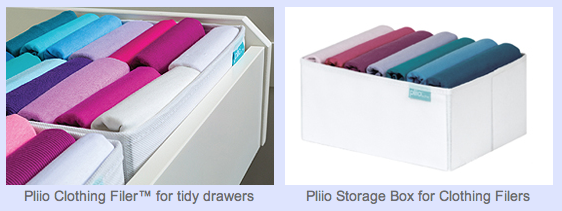 Pliio has also introduced Clothing Pilers that let those who prefer stacked clothes to filed ones enjoy the tidy, uniform wardrobe organization Pliio fans know and love. Instead of folding in thirds like the Filer, the Piler folds clothing in half.
Pliio has also introduced Clothing Pilers that let those who prefer stacked clothes to filed ones enjoy the tidy, uniform wardrobe organization Pliio fans know and love. Instead of folding in thirds like the Filer, the Piler folds clothing in half.
Just fold long- and short-sleeved T-shirts, golf shirts, tops and sweaters around a Clothing Piler as shown below. Pliio Clothing Pilers fit on shelves with depths of 11″ or more. As most closets have 12″ or greater upper shelves, and custom-built shelving tends to be 14″ deep, the Piler is suitable for most shelves. As with the classic Clothing Filers, clothes kept organized with the Clothing Pilers also work great for travel.
The Clothing Pilers currently comes in Medium (8″ W x 17″ L x 1/4″ D) and fit youth sizes 8-10 through adult XL. The Large (10″ W x 17″ L x 1/4″ D) is soon to be in production, and will fit most sizes from adult XS – XXXL. Both should also be suitable for folding light pants, PJs, scarves and dresses. For more details, view the Pliio product page.
Pliio Clothing Filers are available in the U.S. and Canada via Bed, Bath & Beyond, QVC, and The Shopping Channel, in Small ($6.99 for a set of 7) and Medium ($19.99 for a set of 20). The Clothing Pilers are sold at Bed, Bath & Beyond for $19.99 for a set of 7.
Whether you’re fashion-forward or typically-in-T’s, there’s always a workable strategy for keeping your wardrobe accessible and organized. If you’re having difficulty maintaining your closets the way you’d like, a NAPO-affiliated professional organizer is only a click away.

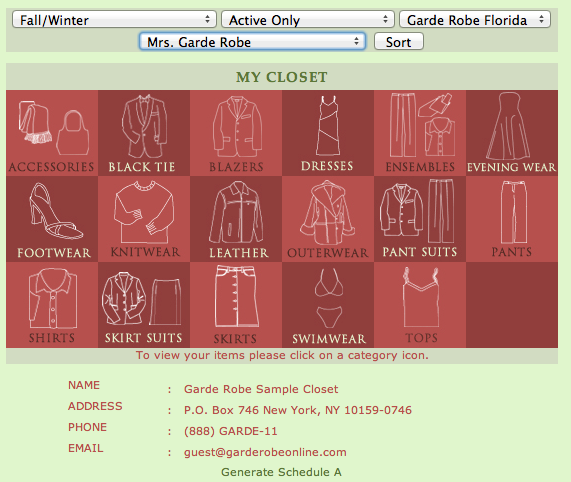

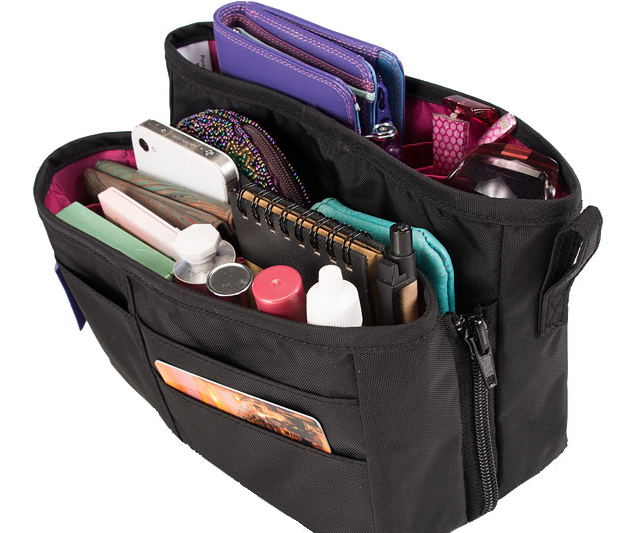
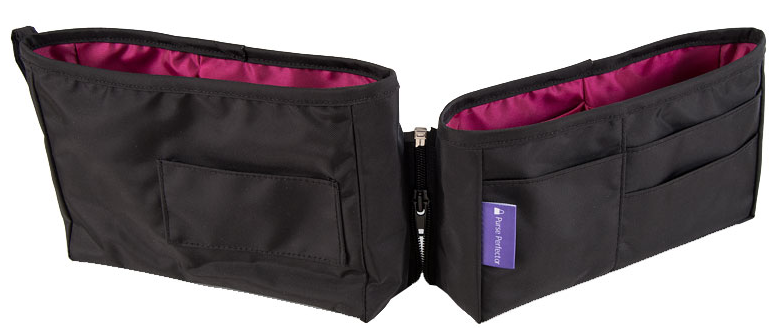


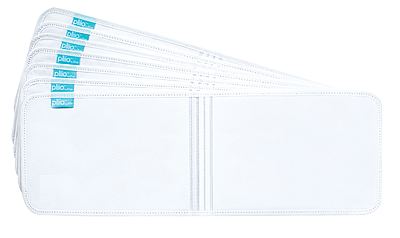




Follow Me